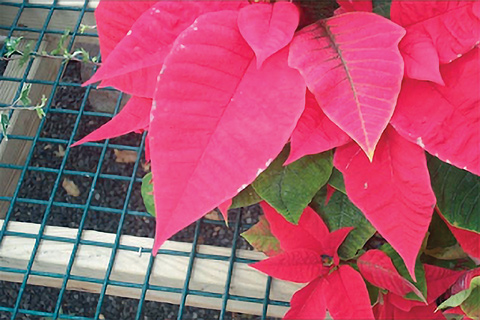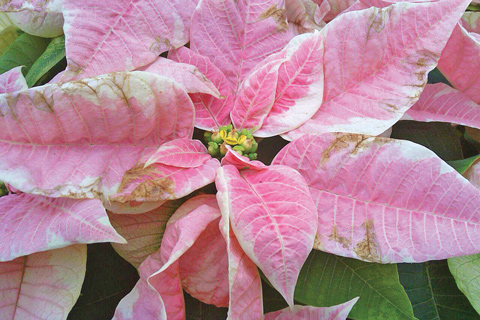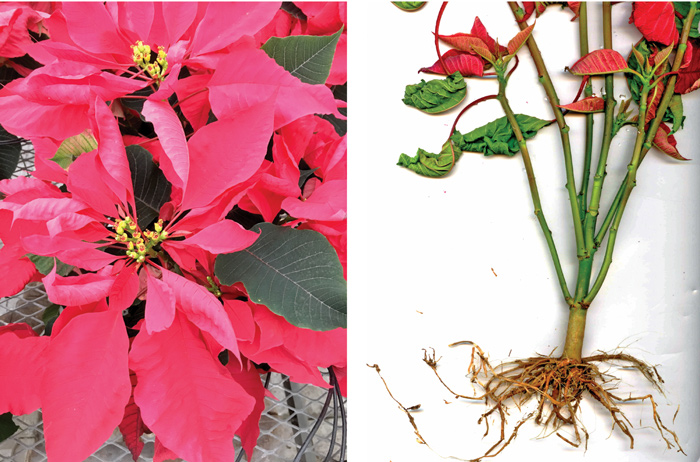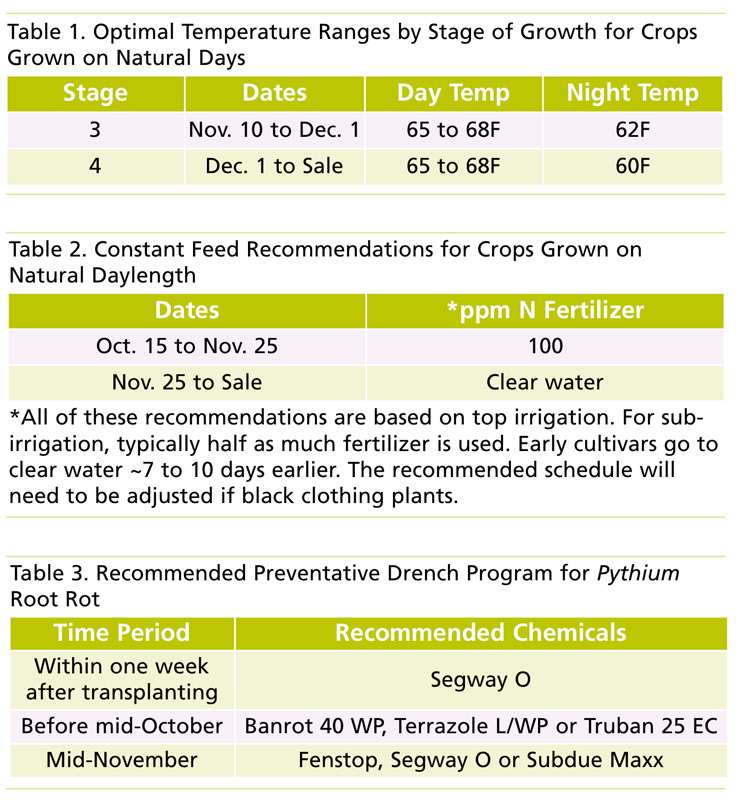6/1/2021
The Best Bract Conditions
Griffin GGSPro

Bract development and overall poinsettia health during the late season can be managed through a combination of cultural and chemical practices.
Bract development and temperature
Temperature has a direct effect on bract expansion, color, maturity and durability. Night temperatures are critical for bract expansion, with 65 to 68F (18 to 20C) being ideal for most varieties. Higher night temperatures can encourage weak bracts, dull color, bract edge problems and foliar diseases. Night temperatures that are too cool can cause bracts not to size up properly. White-flowering varieties can also look green or yellow if night temperatures are too cool. Day temperatures should be kept relatively cool to reduce stretch and increase stem strength.
Pictured: Bract edge burn.
Average daily temperature (ADT) has the largest impact on the rate of bract expansion and saleable color date. The stage of bract development is the best indicator of when to change temperature requirements (Table 1). Stage 3 should begin when bracts are ~75% of finished size. Stage 4 represents the time when bracts are nearly fully expanded or at saleable quality.
For example, early-flowering varieties may enter Stages 3 and 4 up to two weeks earlier than Table 1 indicates. Temperatures below 60F (15C) in Stage 4 can increase the risk of Botrytis on bracts. Maintaining dry air during the last stage when the coolest temperatures occur may be difficult with reduced heat. Cooler air temperatures increase the relative humidity in the plant canopy, which in turn makes condensation more likely. Free moisture on plant surfaces favors Botrytis development.
Maintaining bract health
During the end of the season, healthy bract development is key to a quality product and long-term shelf life. The biggest issues to look out for are Botrytis and bract edge burn, which can go hand in hand. Botrytis is a quickly spreading fungal pathogen that can propagate in damaged material caused by bract edge burn. Bract edge burn is caused by a calcium deficiency.
 Pictured: Poinsettia bract with Botrytis.
Pictured: Poinsettia bract with Botrytis.
Both of these issues can be prevented by using foliar applications of calcium and fungicides. We recommend weekly sprays with calcium chloride dihydrate rather than calcium nitrate because calcium nitrate can occasionally cause additional bract damage. Weekly foliar sprays of calcium chloride dihydrate at 0.5 oz. per 3 gal. or 16 oz. per 100 gal. should be applied at onset of bract color. Affirm WDG, Astun, Medallion WDG, Palladium or Spirato GHN are all effective bract-safe options for preventing and controlling Botrytis. All of these applications should be used in conjunction with a surfactant such as CapSil (¼ tsp. per gal. or 4 oz. per 100 gal.) to reduce any potential for residues. CapSil shouldn’t be applied more than once per week during bract development.
Increasing bract size with Fascination
Inadequate bract expansion can be caused by a number of reasons, including but not limited to: a lower-than-ideal ADT and excessive or late applications of PGRs. Foliar sprays of Fascination can be successful in increasing bract expansion, but carry certain risks. Over-applications of Fascination at this stage of development can lead to weakened petioles, overly large floppy bracts, a change in bract color and accelerated cyathia abscission.
 Pictured far left: Spikey Bract effect with Fascination spray.
Pictured far left: Spikey Bract effect with Fascination spray.
Left: Pythium root rot.
Consider these to be rescue treatments for when the risk of unsaleable plants due to small bracts outweighs the potential risks. Conduct trials on a small number of plants before widespread applications. Bracts sometimes have a “spikey” appearance soon after the treatment, but they usually flatten out within a few days. Fascination can be sprayed at 3 ppm from first color to mid-November. Concentrations should decrease to 1 to 2 ppm during mid-November to December 1. It’s important to wait at least five days to evaluate changes in growth before reapplying if needed.
Nutrition
Once poinsettias have essentially stopped vegetative growth and put their efforts into flowering, their overall nutrient requirements should be cut in half. Applying too much fertilizer during the bract development stage can lead to off-colored bracts, salt stress and disease issues, such as Botrytis and Pythium. Please refer to Table 2 for general recommended feed rates based on dates during the late season.
 Nutrient deficiencies that do occur during the later portion of the season need to be corrected immediately to prevent a decrease in plant quality. Most of these issues can be prevented by making sure your crop is appropriately fed and soil pH is in the correct range leading into flower. We recommend testing your tissue and soil prior to first color in order to correct any issues before bracts begin developing.
Nutrient deficiencies that do occur during the later portion of the season need to be corrected immediately to prevent a decrease in plant quality. Most of these issues can be prevented by making sure your crop is appropriately fed and soil pH is in the correct range leading into flower. We recommend testing your tissue and soil prior to first color in order to correct any issues before bracts begin developing.
The most common deficiencies typically fall under the category of molybdenum (Mo), manganese (Mn), magnesium (Mg), iron (Fe) and calcium (Ca). Mn, Mg and Fe will increase in availability to the plant as soil pH goes down, while Mo and Ca will decrease in solubility. Utilizing a micronutrient package such as S.T.E.M. or M.O.S.T. in combination with adjusting soil pH within 6.0 to 6.5 can help correct all of these deficiencies except Ca. Calcium deficiencies can be corrected by using a calcium-containing fertilizer, such as 15-0-15, and foliar sprays of calcium chloride dihydrate as described previously.
Late-season Pythium
There are various Pythium species that can cause root rot issues throughout the season. Most often, we can prevent root rot by supplying the appropriate concentration of fertilizer based on the stage of growth as described above and maintaining an appropriate irrigation frequency. Applying high amounts of fertilizer can lead to salt stress and damaged root systems. These conditions are ideal for Pythium to colonize and overtake the plant. Pythium can also be prevented with scheduled fungicidal drenches. Table 3 shows a recommended drench program for preventing root rot issues throughout the season. GT
Anyone from the Griffin GGSPro team can be reached at ggsprotech@griffinmail.com.